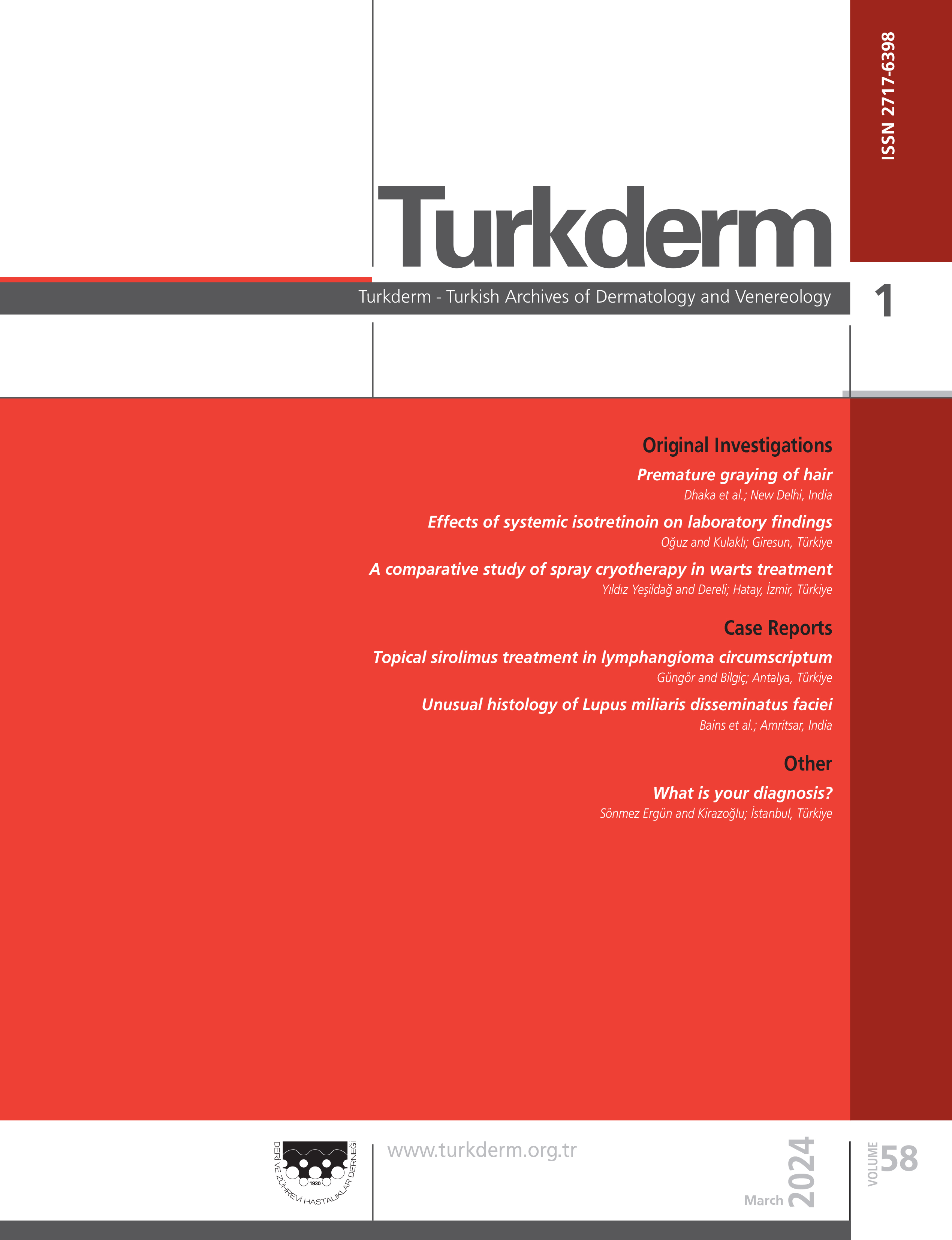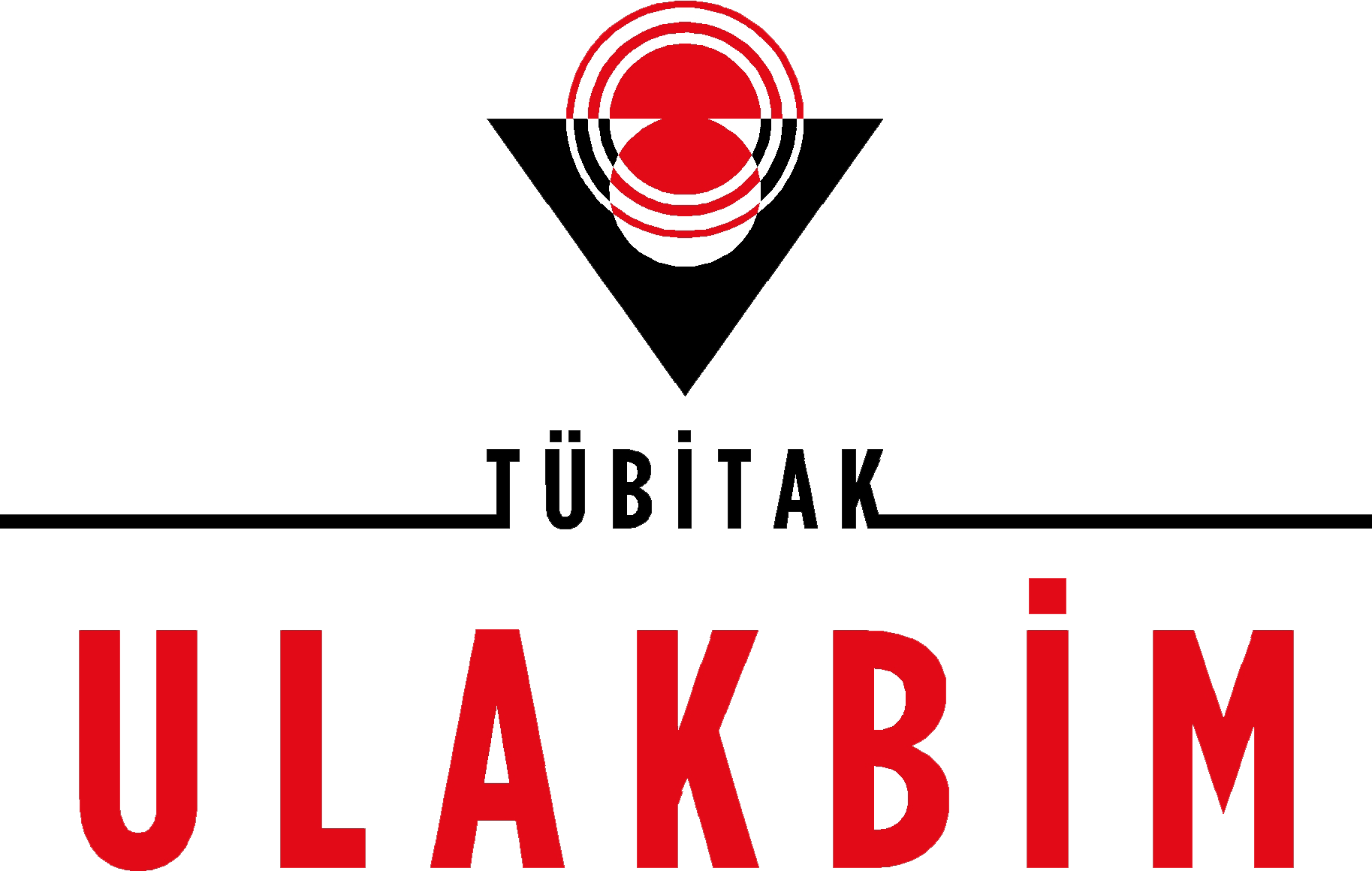Volume: 43 Issue: 2 - 2009
| EDITORIAL | |
| 1. | Kongrelerimiz ve Derneklerimiz Ertuğrul H. AydemirPage 43 Abstract | |
| REVIEW ARTICLE | |
| 2. | Treatment Approaches for Cutaneous Leishmaniasis Sema Aytekin Pages 44 - 47 Kutanöz layşmanyazis (KL), layşmanya genusundan bazı parazitlerle oluşan tropikal bir hastalıktır. Ülkemizde, KLin sıklıkla etkeni L. mayor ve L. tropika olup çok farklı klinik görünümleri vardır. KLde tedavide amaç, mukozal yayılımı önlemek, iyileşmeyi hızlandırmak ve skar gelişimini önlemektir. Topikal paromomisin, kriyoterapi, lokalize kontrollü ısı, karbondioksit lazer veya intralezyonel beş değerli antimon kullanımı gibi lokal ve fiziksel tedaviler etkilidir. İntralezyonel antimon kullanımı halen en iyi tedavi seçeneğidir. Dünya Sağlık Örgütü lezyon kenarından lezyon içine lezyon beyazlayana kadar injeksiyonu önerir. Büyük, çok sayıda, dirençli, rekürren lezyonlarda sistemik antimonaller kullanılmalıdır. Antimonal tedaviye cevap vermeyen lezyonlar için antimon ile allopürinol ve pentoksifilin gibi ilaç kombinasyonları kullanılmalıdır. Cutaneous leishmaniasis (CL) is a widespread tropical infection caused by numerous different species of Leishmania protozoa. In our country, CL is due frequently to L. major and L. tropica. Its clinical presentation is extremely diverse. Treatment of CL aims to prevent mucosal invasion, to accelerate the healing of skin lesions, and avoid disfiguring scar. Local and physical treatment modalities including topical paromomycin, cryotherapy, localized controlled heat, carbon dioxide laser therapy, or pentavalant antimonals can be effective against. Intralesional antimonals are still the drug of choice may patients. WHO recommends an injection of drug under edges of the lesions and the entire lesion until the surface has blanched. Parenteral antimonials are useful for large, persistent or recurrent lesions. Combinations with other drugs such as allopurinol, pentoxifylline must be used for antimony unresponsive lesions. |
| ORIGINAL INVESTIGATION | |
| 3. | Investigation of Serum Leptin Levels in Psoriatic Patients Nurhal Mercan Bozkurt, Mehmet Yıldırım, Ali Murat Ceyhan, Yusuf Kara, Hüseyin Vural Pages 48 - 52 Amaç: Psoriasis kronik seyirli, T hücre aracılı hiperproliferatif bir deri hastalığıdır. Leptin, Th1 yanıtını sitümule ederken Th2 yanıtını baskılayan bir adipokindir. Leptinin T hücre immünitesi üzerinde önemli rol oynaması nedeniyle psoriasis immünopatogenezinde de yeri olabileceği düşünülerek bu çalışmada leptin ile psoriasis arasındaki olası ilişkinin araştırılması amaçlanmıştır. Gereç ve Yöntem: Ellidört psoriasisli hasta ile yaş, cinsiyet ve vücut kitle indeksleri uyumlu sağlıklı 50 kişide serum leptin, interlökin (IL)-1b, IL-6, IL-8, TNF-a ve nitrik oksit (NO) düzeyleri ölçüldü. Bulgular: Psoriasisli hastalar ile kontrol grubunun serum leptin konsantrasyonları arasında istatistiksel olarak anlamlı fark bulunmadı (p=0,568). Serum leptin düzeyi ile PASI değeri, hastalık süresi, tipi, IL-1b, IL-6, IL-8, TNF-a ve NO arasında korelasyon saptanmadı. Serum IL-8 ve TNF-a düzeyleri psoriasisli hastalarda kontrol grubuna göre anlamlı olarak yüksek bulundu (sırasıyla p=0,002 ve p=0,020). Hasta ve kontrol grubu arasında IL-1b, IL-6 ve NO düzeyleri açısından istatistiksel olarak anlamlı fark saptanmadı. Sonuç: Bu sonuçlar psoriasisli hastalarda serum leptin düzeyi ölçülmesinin patogenez açısından belirleyici rol oynamadığını ve leptinin psoriasisin şiddeti ve kronikliği ile ilgili bir belirteç olmadığını göstermektedir. Background and Design: Psoriasis is a chronic, T cell mediated hyperproliferative skin disease. Leptin is an adipokine that stimulates Th1 immune response while suppressing Th2 immune response. Because that leptin plays an important role in the T cell immunity, it is aimed to investigate the relation between psoriasis and leptin and whether leptin plays a role in the immunopathogenesis of psoriasis in the present study. Mateiral and Method: Serum leptin, interleukin (IL)-1b, IL-6, IL-8, TNF-a and nitric oxide (NO) levels were measured in 54 psoriatic patients and age, sex and body mass index matched 50 healthy control subjects. Results: The mean serum leptin concentration was not statistically different in psoriatic patients compared with the controls (p=0.568). Serum leptin levels were not correlated with PASI score, duration and clinical type of the disease as well as IL-1b, IL-6, IL-8, TNF-a and NO levels. IL-8 and TNF-a levels were significantly higher in patients with psoriasis than healthy control subjects (p=0.002 and p=0,020 respectively). The mean serum IL-1b, IL-6 and NO levels were not statistically different in patients when compared with control subjects. Conclusion: These results showed that leptin may not play a significant role in the immunopathogenesis of psoriasis and leptin could not be accepted as a marker to assess severity of the disease. |
| 4. | Serum High Sensitivity C Reactive Protein and Homocysteine Levels in Patients with Mild to Moderate Psoriasis Didem Didar Balcı, Zafer Yönden, Çiğdem Asena Doğramacı, Nizami Duran Pages 53 - 57 Amaç: Psoriyazisin artmış kardiyovasküler risk profili ile ilişkisi bildirilmiştir. Yüksek sensitif C reaktif protein (hs-CRP) ve homosistein (Hcy) sonradan gelişebilecek kardiyovasküler olay riskini gösterebilen kanıtlanmış güncel biyolojik göstergelerdir. Bu çalışmanın amacı hafif ve orta şiddetli psoriyazis hastalarında hs-CRP, Hcy ve folik asit düzeylerini araştırmaktır. Gereç ve Yöntem: Elli bir ardışık hafif ya da orta şiddette psoriyazis vulgaris, yaş ve cinsiyet açısından eşleştirilmiş 32 sağlıklı kontrol çalışmaya alındı. Serum Hcy düzeylerini etkileyebilecek faktörler ekarte edildikten sonra hs-CRP, Hcy ve folik asit düzeylerini saptamak için kan örnekleri alındı. Ek olarak lipid düzeyleri de ölçüldü. Bulgular: Psoriyazis hastalarının ortalama Hcy değerleri kontrollerle karşılaştırıldığında anlamlı olarak yüksekti (p=0,001). Psoriyazisli hastalarla kontroller arasında hs-CRP ve folik asit düzeyleri açısından anlamlı farklılık yoktu (p>0,05). Total kolesterol (TC) yüksek dansiteli lipoprotein kolesterol (HDL C) oranı psoriyazisli hastalarda kontrollere göre anlamlı derecede yüksekti (p=0,044). Psoriyazis hastalarında Hcy düzeyleri ile cinsiyet arasında anlamlı ilişki mevcuttu. Psoriyazis hastalarında hs-CRP değerleri vücut kitle indeksi (BMI) ve TC ile anlamlı pozitif korelasyon gösterdi (p<0,05). Sonuç: Hafif ya da orta şiddetteki psoriyazis hastaları ile kontroller arasında serum hs-CRP ve folik asit düzeyleri açısından anlamlı farklılık gözlenmedi. Ancak psoriyazis hastalarında serum Hcy düzeylerinde artış ve folik asit düzeyleriyle ters korelasyon izlendi. Bu biyolojik göstergeler psoriyaziste aterosklerotik riskin değerlendirilmesinde ek bilgi sağlayabilir. Background and Design: Psoriasis has been reported to be associated with increased cardiovascular risk profile. High sensitivity C reactive protein (hs-CRP) and homocysteine (Hcy) have been demonstrated to be novel biomarkers for subsequent cardiovascular events. The aim of the present study was to examine hs-CRP, Hcy and folic acid levels in patients with mild to moderate psoriasis vulgaris. Material and Method: Fifty one consecutive patients with mild to moderate psoriasis vulgaris and thirty two sex- and age-matched healthy controls were included in this study. After excluding factors that may affect serum Hcy levels, blood samples were obtained for hs-CRP, Hcy and folic acid determination. Lipid levels were also evaluated. Results: The mean Hcy values of the psoriasis patients was significantly higher, compared with the controls (p=0.001). There were no significant difference in hs-CRP and folic acid levels between psoriasis patients and controls (p>0.05). The total cholesterol (TC) high density lipoprotein cholesterol (HDL C) ratio was significantly higher in patients with psoriasis than in controls (p=0.044). There was a significant relationship between Hcy level and sex in psoriasis patients. The hs-CRP values had significant positive correlation with body mass index (BMI) and TC in psoriasis patients (p<0.05). Conclusion: Serum hs-CRP and folic acid levels did not show any significant difference between patients with mild to moderate psoriasis and controls. However, serum Hcy levels increased and inversely correlated with folic acid levels in psoriasis patients. These biomarkers could provide additional information in the evaluation of the atherosclerotic risk in psoriasis. |
| 5. | Sympathetic Skin Response in Patients with Vitiligo Asena Çiğdem Doğramacı, Esra Emine Okuyucu Pages 58 - 60 Amaç: Sempatik deri cevabı (SDC), sudomotor sempatik fonksiyonu değerlendirmek amacıyla kullanılan elektrofizyolojik bir testtir. Bu çalışmanın amacı, vitiligo hastalarında bu test kullanılarak sempatik sinir sistemi disfonksiyonunu değerlendirmektir. Gereç ve Yöntem: Çalışmaya jeneralize vitiligo tanısı almış 26 hasta (20 kadın, 6 erkek) ile yaş ve cinsiyetleri uyumlu 23 sağlıklı gönüllü (18 kadın, 5 erkek) alındı. Katılımcıların SDCı yarı karanlık bir odada, supine pozisyonunda Medelec elektronöromyografi cihazı kullanılarak değerlendirildi. Bulgular: Hastaların yaş ortalaması 30,6±12,8, kontrol grubunun ise 29,7±10,5 idi. İki grup arasında yaş ve cinsiyet açısından istatistiksel olarak anlamlı farklılık yoktu (p>0,05). Ortalama latans vitiligo hastalarında 1,48±0,58 ms, kontrol grubunda ise 1,52±0,46 ms olarak bulundu (p=0,944). Ortalama amplitüd ise vitiligo hastalarında kontrol grubuna göre küçük olmakla birlikte fark istatistiksel olarak anlamlı değildi (sırasıyla, 3,83±2,95 mV ve 5,09±3,60 mV) (p=0,100). Sonuç: Vitiligo hastalığının sempatik deri cevabı üzerinde herhangi bir etkisi olmadığı tespit edildi. Background and Design: The sympathetic skin response (SSR) is a electrophysiological test used as an index of sudomotor sympathetic function. The aim of this study was to evaluate possible sympathetic nervous system dysfunction in vitiligo patients with the sympathetic skin response. Material and Method: Sympathetic skin response was studied in 26 patients (20 female and 6 male) with clinical definitely generalized vitiligo and 23 healthy controls (18 female and 5 male). This study was performed in a semi-darkened room while the patients were in supine position. SSR recordings in all of the subjects were performed by a Medelec electroneuromyograph. Results: The average age of patients and controls were 30.6±12.8 and 29.7±10.5, respectively. No demographic differences existed statistically between patients and controls (p>0.05). The mean latency of SSR in vitiligo patients [mean SSR latency in patients, 1.48±0.58 ms vs controls, 1.52±0.46 ms (p=0.944)] was not significantly different compared with the controls. The mean amplitude of SSR in vitiligo patients (mean SSR amplitude in patients, 3.83±2.95 mV vs controls, 5.09±3.60 mV) was smaller compared with the controls, but this difference was not significant (p=0.100). Conclusion: We conclude that vitiligo has no significant effect on the sympathetic skin response. |
| 6. | Subclinical Peripheral Neuropathy in Behcets Disease Esra Emine Okuyucu, Didem Didar Balcı, Ayşe Turhanoğlu, Taşkın Duman, Serkan Yılmazer, Jülide Zehra Yenin Pages 61 - 64 Amaç: Behçet hastalarında santral sinir sistemi tutulumu iyi bilinmekle beraber periferik sinir sistemi tutulumu henüz netleşmemiştir. Bu çalışmanın amacı Behçet hastalarında elektrofizyolojik inceleme ile subklinik periferik nöropatinin sıklığını ve özelliklerini değerlendirmektir. Gereç ve Yöntem: Çalışmaya, nörolojik olarak semptom ve bulguları olmayan 33 Behçet hastası (23 erkek, 10 kadın) ile yaş ve cinsiyetleri uyumlu 33 sağlıklı gönüllü alındı. Periferik sinir işlevlerini etkileyebilecek diğer etkenleri saptamaya yönelik tetkikleri yapıldı. Çalışmaya katılan tüm hasta ve sağlıklı gönüllülere standart nörografik prosedürler kullanılarak elektrofizyolojik inceleme yapıldı. Sonuçlar Amerikan Diyabet Cemiyeti Diyabetik Nöropati protokolüne göre değerlendirildi. Bulgular: Sinir ileti çalışması 33 hastanın 11inde (7 erkek, 4 kadın, %33,3) anormaldi. Beş (%15) hastada sensorimotor polinöropati, 4 (%12) hastada sural sensoriyel nöropati, 1 (%3) hastada median ve tibial motor nöropati mevcuttu. Yedi (%21) hastada sural sensöriyel sinir elde edilemedi ve geç F latansı 2 (%6) hastada mevcuttu. Kontrol grubu elektrofizyolojik olarak normaldi ve fark istatistiksel olarak anlamlıydı (p<0,0001). Periferik nöropati varlığı ile cinsiyet arasında da istatistiksel olarak anlamlı ilişki yoktu (p=0,696) Sonuç: Behçet hastalarında detaylı nörolojik muayene normal olmasına rağmen subklinik nöropati gözlenebilir. Elektrofizyolojik inceleme, bu hastalarda subklinik periferik nöropatinin tespitinde faydalı bir yöntemdir. Background and Design: Central nervous system involvement is well known in patients with Behcets disease but studies evaluating peripheral nervous system is not usual. The aim of this study is to evaluate the frequency and characteristics of subclinical neuropathy in patients with Behcets disease. Material and Method: Thirty three Behcets disease patients (23 male, 10 women) with no evident neurological sign and symptom and 33 healthy volunteers were enrolled to the study. To exclude the other causes of peripheral neuropathy, some laboratory investigations were made. Electrophysiological studies of peripheral nerves were performed to all patients and healthy volunteers. The results were assessed according to the American Diabetes Association Diabetic Neuropathy Protocol. Results: Nerve conduction studies were abnormal in 11 of 33 patients (7 men, 4 women; 33.3%). Five patients (15%) had sensorymotor polyneuropathy, 4 (12%) has sural sensory polyneuropathy, 1 (3%) had median and tibial motor neuropathy. Sural nerve were unobtainable in 7 (21%) patients. 2 patients (6%) had prolonged F latency. Control group were normal electrophysiologically and the difference was statistically important (p<0.0001). There was no correlation between peripheral neuropathy and gender (p=0.696). Conclusion: Despite the detailed neurological examination, subclinical peripheral neuropathy can be seen in patients with Behçets disease. Electrophysiological studies are useful for the early detection of peripheral neuropathy in these patients. |
| CASE REPORT | |
| 7. | Charcot-Marie-Tooth Disease Type 2B Şenay Durdu, Kadriye Koç, Deniz Balaban, Aynur Karaoğlu Pages 65 - 67 Charcot-Marie-Tooth (CMT); peroneal muskuler atrofi, herediter motor ve duyusal nöropati (HMSN) diye de bilinir. Genetik geçişli periferik nöropatilerin en yaygın olanıdır. CMT aslında tek bir hastalık olmayıp klinik belirtileri kabaca birbirine benzer bir hastalık grubudur. Bu grup içinde CMT tip 1 den sonra görülme sıklığı en yüksek olan CMT tip 2 dir. Belirtiler sıklıkla çocukluk ve gençlik çağında başlar. En sık alt ekstremitelerin periferik sinirleri etkilenmekle birlikte üst ekstremiteler de etkilenebilir. Alt ekstremite kaslarında güç kaybı ve atrofi nedeni ile düşük ayak, pes kavus, pes planus, çekiç parmak gibi çeşitli ayak deformiteleri görülür. Bunun yanısıra duyusal sinirlerin dejenerasyonuna bağlı olarak kallus tarzında oluşumlar, tekrarlayan ayak ülserleri, osteonekroz, osteoliz ve spontan amputasyonlar tabloya eşlik edebilir. EMG de sinir ileti hızının değişmediği, ancak amplitütte azalmaya yol açan aksonal tip sensoriomotor nöropati bulguları saptanır. Biz burada 55 yaşında, yaklaşık 33 yıldır tekrarlayıcı ayak ülserleri ve self amputasyonları olan, EMG bulgusu aksonal nöropatiye uyan, 20 yaşındaki oğlunda da benzer şikayetler bulunan bir olguyu sunmaktayız. Chatcot-Marie-Tooth (CMT) is also known as peroneal muscular atrophy and hereditary motor-sensory neuropathy (HMSN). It is the most commonly encountered inherited peripheral neuropathy. Actually, CMT is not a single disease, but is a group of disorders with similar symptoms. CMT type 2 is the second most common form after CMT type1. Symptoms usually begin in childhood or early adulthood. Mostly the peripheral nerves of the lower extremities and occasionaly upper extremities may be affected. Motor nerve involvoment induces distal muscle weakness and atrophy in the lower extremities that may result in foot deformities known as foot drop, pes cavus, pes planus, hammer toe etc. As a result of sensorial nevre degeneration, callus, recurrent foot ulcers, osteonecrosis, osteolysis and spontaneous amputation may accompany the disease. The speed of nerve conduction is not changed in the EMG, but axonal type sensorymotor semptoms that lead to a decrease of amplitude. We report here a 55 year old man with recurrent foot ulcers for 33 years and self amputations, whose EMG findings suggest acsonal neuropathy and who also has a 20 year - old son with similar complaints. |
| 8. | A Case of Kindler Syndrome Reyhan Çelik, Kadriye Koç, Deniz Balaban, Aynur Karaoğlu Pages 68 - 69 Kindler sendromu nadir görülen genetik bir hastalıktır. Doğumdan itibaren görülmeye başlayan akral büller ve fotosensitiviteyi, zamanla progresif poikiloderma ve deri atrofisi izler. Kindler sendromu bazal keratinositlerdeki aktin hücre iskeletinin ekstrasellüler matrikse tutunmasını sağlayan kindlin-1 proteinini kodlayan KIND-1 genindeki mutasyon sonucu gelişir. Burada ailesinde benzer lezyonlar olmayan; yaygın poikiloderma, parmak aralarında perdelenme, palmoplantar hiperkeratoz, tırnak distrofisi, periodontit ve ektropiyonu bulunan, öyküsünde erken infantil dönemde bül formasyonu tarif eden 18 yaşında bir bayan olgu sunulmaktadır. Kindler syndrome is a rare genetic disorder, acral blistering and photosensitivity appears from birth, followed by progressive poikiloderma and cutaneous atrophy. Kindler syndrome is caused by mutations in KIND-1 gene encoding the protein kindlin-1 which is involved in the attachment of the actin cytoskeleton to the extracellular matrix basal keratinocytes. Here we report a 18-year-old woman presented with generalized poikiloderma, webbing of the toes and fingers, palmoplantar hyperkeratosis, nail dystrophy, periodontitis and ectropione with a history of blister formation in early infant. |
| 9. | A Case of Mucormycosis Presented with Oral Ulcers Pınar Yüksel Başak, Emel Sesli Çetin, Hicran Yetkin, Vahide Baysal Akkaya Pages 70 - 72 Oral ülserler ve boğaz ağrısı yakınması ile başvurup pansitopeni saptanan 62 yaşındaki erkek hasta akut myeloid lösemi tanısı almıştır. Antibiyoterapiye rağmen ateşinin düşmemesi ve oral lezyonlardan Rhizopus spp. identifiye edilmesi üzerine tedavisine iki hafta süreyle amfoterisin B eklenmiştir. Oral ülserlerinde tamamen düzelme saptanan olgu, nadir görülmesi yanında mortalitesi yüksek olan mukormikozisin, immunsupresyonu olan hastalarda özellikle oral mukoza lezyonlarının ayırıcı tanısında akılda bulundurulması gerektiğine işaret etmek amacıyla sunulmuştur. A 62-year-old male patient suffering from oral ulcers and painful throat with pancytopenia was diagnosed as acute myeloid leukemia. Because of uncontrolled fever despite antibiotherapy and that Rhizopus spp. was identified from oral lesions, amphotericin B was added to treatment for two weeks. Oral lesions were completely cleared thereafter and this case was presented to point out that mucormycosis must be kept in mind in the differential diagnosis of oral mucosal lesions in patients with immunosuppression as well as it is a rare disease with high mortality. |
| WHAT IS YOUR DIAGNOSIS? | |
| 10. | A Rare Cause of Congenital Hearing Loss Hayrullah Alp, Esma Alp Pages 73 - 74 Abstract | |
| TURKDERM-6637 | |
| 11. | Acı Kaybımız Page 75 Abstract | |
| 12. | Haberler Pages 76 - 77 Abstract | |
| NEW PUBLICATIONS | |
| 13. | Shimuzus Textbook of Dermatology Page 78 Abstract | |
| TURKDERM-6637 | |
| 14. | KONGRE TAKVİMİ Page 79 Abstract | |






















